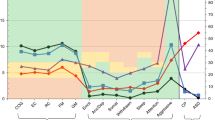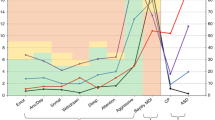Abstract
Research findings: Child and family characteristics from early infancy (birth–3 months adjusted age, AA) and toddler period (24–30 months) were examined as potential predictors of behavior problems and social skills at 7.5 years of age in 90 LBW infants with IVH and/or ELBW who were part of a longitudinal study of early intervention effectiveness. Severity of medical problems at birth and child temperament at 3 months AA were associated with future social skill levels, but not with behavior problems. Family variables in the first months of the child's life including low income, single parent household, and high parenting stress were significantly correlated with behavior problems at 7.5 years of age. Difficult temperament and elevated parenting stress in the toddler period were strongly associated with later behavior problems. Toddler developmental quotient (DQ) was a strong predictor of future social skills. Practice or policy: These data highlight the importance of early intervention that targets child behavior and emotional adjustment along with cognitive development, especially in low income and single parent households. Interventions that target parent-child interaction and parent stress are also crucial in these populations, even beyond the birth-three period.
Similar content being viewed by others
References
Feil EG, Severson HH, Walker HM: Screening for emotional and behavioral delays: The early screening project. J Early Int 21:252–266, 1998.
Sanson A, Smart D, Prior M, Oberklaid F: Precursors of hyperactivity and aggression. J Am Acad of Child Adol Psychiatry32:1207–1216, 1993.
Stormont M: Early child risk factors for externalizing and internalizing behaviors: A 5-year follow-forward assessment. J Early Int 23:180–190, 2000.
Barkley RA:. Attention-deficit hyperactivity disorder: A handbook for diagnosis and treatment (2nd ed.). New York: Guilford Press, 1998.
Carlson EA, Jacobvitz D, Sroufe LA: A developmental investigation of inattentiveness and hyperactivity. Child Dev 66:37–54, 1995.
Robson AL, Pederson DR: Predictors of individual differences in attention among low birth weight children. J Dev Beh Pediatr 18:13–21, 1997.
Escalona S: Social and other environmental influences on the cognitive and personality development of low birthweight infants. Am J Ment Def 88:508-512, 1984.
Hack M, Friedman H, Fanaroff AA: Outcomes of extremely low birth weight infants. Pediatrics98:931–937, 1996.
Minde K, Goldberg S, Perrotta M, Washington J, Lojkasek M, Parker K: Continuities and discontinuities in the development of 64 very low birthweight infants. J Child Psychol Psychiatry 30:391–404, 1989.
Goldberg S, Corter C, Lojkasek M, Minde K: Prediction of behavior problems in four-year-olds born prematurely. Ann Prog Child Psychiatry Child Dev 92–113, 1991.
Bennett FC, Scott DT: Long-term perspective on premature infant outcome and contemporary intervention issues. Sem Perinatology 21:190–201, 1997.
Merrell KW, Popinga, MR: The alliance of adaptive behavior and social competence: An examination of relationships between the scales of independent behavior and the social skills rating system. Res Dev Disabilities 15(1): 39–47, 1994.
Hill JW, Wehman P, Hill M, Goodall P: Differential reasons for job separation of previously employed persons with mental retardation. Ment Retardat 24: 347–351, 1986.
Salzberg CL, Lignugaris/Kraft B, McCuller GL: Reasons for job loss: A review of employment termination studies of mentally retarded workers. Res Dev Disabilities 9: 153–170, 1988.
Innocenti MS: 1990–95 Final report of the longitudinal studies of the effects of early intervention for children with disabilities (contract # HS90010001). Early Intervention Research Institute: Utah State University, Logan, 1996.
Boyce GC, Smith TB, Immel N, Casto G, Escobar C: Early intervention with medically fragile infants: Investigating the age-at-start question. Early Ed Dev 4:290–305 (1993).
Saylor CF, Casto G, Huntington L: Predictors of developmental outcomes for medically fragile early intervention participants. J Ped Psychol 21:869–887, 1996.
Achenbach TM, Edelbrock CS: Child behavior checklist. Burlington, VT: University of Vermont, 1987.
Gresham F, Elliott S: The social skills rating system manual. Circle Pines, Minnesota: American Guidance Services, Inc., 1990.
Dunst CJ, Jenkins V, Trivette CM: Family support scale: Reliability and validity. J Indiv Fam Community Wellness1:45–52, 1984.
Dunst CJ, Leet HE: Family resource scale. Morganton, NC: Western Carolina Center, 1985.
McCubbin HS, Patterson JM, Wilson LR: Family inventory of life events and changes. St. Paul, MN, University of Minnesota, 1983.
Moos RH: Family environment scale. Palo Alto, CA: Consulting Psychology Press, Inc., 1974.
Abidin RR: Manual for the parenting stress index. Charlottesville, VA: Pediatric Psychology Press, 1983.
Shonkoff JP, Hauser-Cram P, Krauss MW, Upshur CC: Development of infants with disabilities and their families: Implications for theory and service delivery. Monog Soc Res Ch Dev57(6, Serial No. 230), 1992.
Fullard, W., McDevitt, S., & Carey, W. (1984). Toddlers temperament scale for 1–3 year old children. J Ped Psychol, 9, 205–217.
Seifer R, Sameroff A: The concept, measurement, and interpretation of temperament in young children: A survey of research issues. Advances Dev Beh Peds 7: 1–43, 1986.
Fullard W, McDevitt SC, Carey WB: Assessing temperament in one-to three-yearold children. J Ped Psychol 9(2):205–217, 1984.
Newborg J, Stock J, Wnek L, Guidubaldi J, Svinicki J: Battelle developmental inventory. Allen, TX: DLM Teaching Resources, 1984.
Gerken KC, Eliason MJ, Arthur CR: The assessment of ar-risk infants and toddlers with the Bayley Mental Scale and the Battelle Developmental Inventory: Beyond the data. Psychol in Schools 31(3):181–187, 1994.
Onufrak B, Saylor CF, Taylor MJ, Eyberg SM, Boyce GC: Determinants of responsiveness in mothers of children with intraventricular hemorrhage. J Ped Psychol 20:587–599, 1995.
Author information
Authors and Affiliations
Rights and permissions
About this article
Cite this article
Saylor, C.F., Boyce, G.C. & Price, C. Early Predictors of School-Age Behavior Problems and Social Skills in Children with Intraventricular Hemorrhage (IVH) and/or Extremely Low Birthweight (ELBW). Child Psychiatry Hum Dev 33, 175–192 (2003). https://doi.org/10.1023/A:1021402012924
Issue Date:
DOI: https://doi.org/10.1023/A:1021402012924




